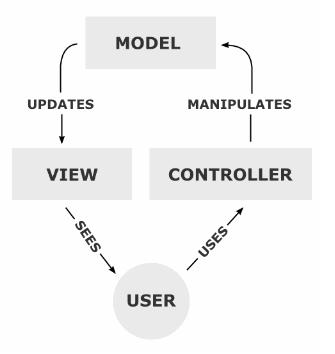Model view controller (MVC) is a software architecture pattern which separates the representation of information from the user’s interaction with it
In addition to dividing the application into three kinds of components, the MVC design defines the interactions between them.
A controller can send commands to its associated view to change the view’s presentation of the model (e.g., by scrolling through a document). It can also send commands to the model to update the model’s state (e.g., editing a document).
A model notifies its associated views and controllers when there has been a change in its state. This notification allows the views to produce updated output, and the controllers to change the available set of commands. A passive implementation of MVC omits these notifications, because the application does not require them or the software platform does not support them.
A view requests from the model the information that it needs to generate an output representation.

SFDC MVC: You can write your VIEW pages using SFDC visual force (VF pages). VF pages are similar to our JSP pages. Each VF page is associated with a Controller. you can make use to already built Standard controllers or you can write your own controller using Apex language. Apex is OO and very much similar to our JAVA. you can also write Model Classes using Apex.
Visualforce uses the traditional model-view-controller (MVC) paradigm, with the option to use auto-generated controllers for database objects, providing simple and tight integration with the database. You can write your own controllers, or extensions to controllers, using Apex Code. Visualforce also provides AJAX components, and embeds the formula expression language for action, data and component binding interaction.
Salesforce.com is award winning tool to manage all the data of sales team of an organization. The flexibility and assurance of safe data provided by Salesforce.com results into nonparallel development capabilities to the developer.
SFDC MVC pattern contains below three modules:
- Model
- View
- Controller
Model: What schema and data does salesforce uses to represent the system completely. In salesforce, we can say that sObjects are the model as every entity in salesforce is mapped to some sObject.
View: How the schema and data is represented. Visualforce is used to present the data to users.
Controller: How the interface actions. Controllers are used to perform the actions whenever users interact with visual force.
In SFDC
1. Visual Force pages, Page Layouts, Tabs comes under View Layer of Model View controller .
2. Workflows, Apex Classes, Triggers comes under Controller part in Model View controller .
3. Objects, Fields, Relationships comes under Model Layer of Model View Controller .

Hello, just wanted to tell you, I liked this blog post. Karlee Constantine Pollie
I am continuously looking online for ideas that can aid me. Thank you! Rogelio Roettger
Wow, great blog article. Awesome. Keven Pulse
These are really impressive ideas in on the topic of blogging.
You have touched some nice points here. Any way keep up
wrinting.
Greate article. Keep writing such kind of info on your blog.
It is a very good useful article I like to read such articles
Awesome article post.Much thanks again.
Awesome article post.Much thanks again.
I read a great article with pleasure, I hope it will continue
You have a quality site, I congratulate you on this
I feel very lucky to follow your page
You produce quality content, congratulations on this
I enjoyed reading a very successful article
I loved your blog.Really looking forward to read more. Will read on…
Some genuinely prime posts on this site, saved to fav. Steffie Kristo Percival
What’s up colleagues, its impressive piece of writing concerning educationand completely
explained, keep it up all the time.